Our Sanctuary Square Windows
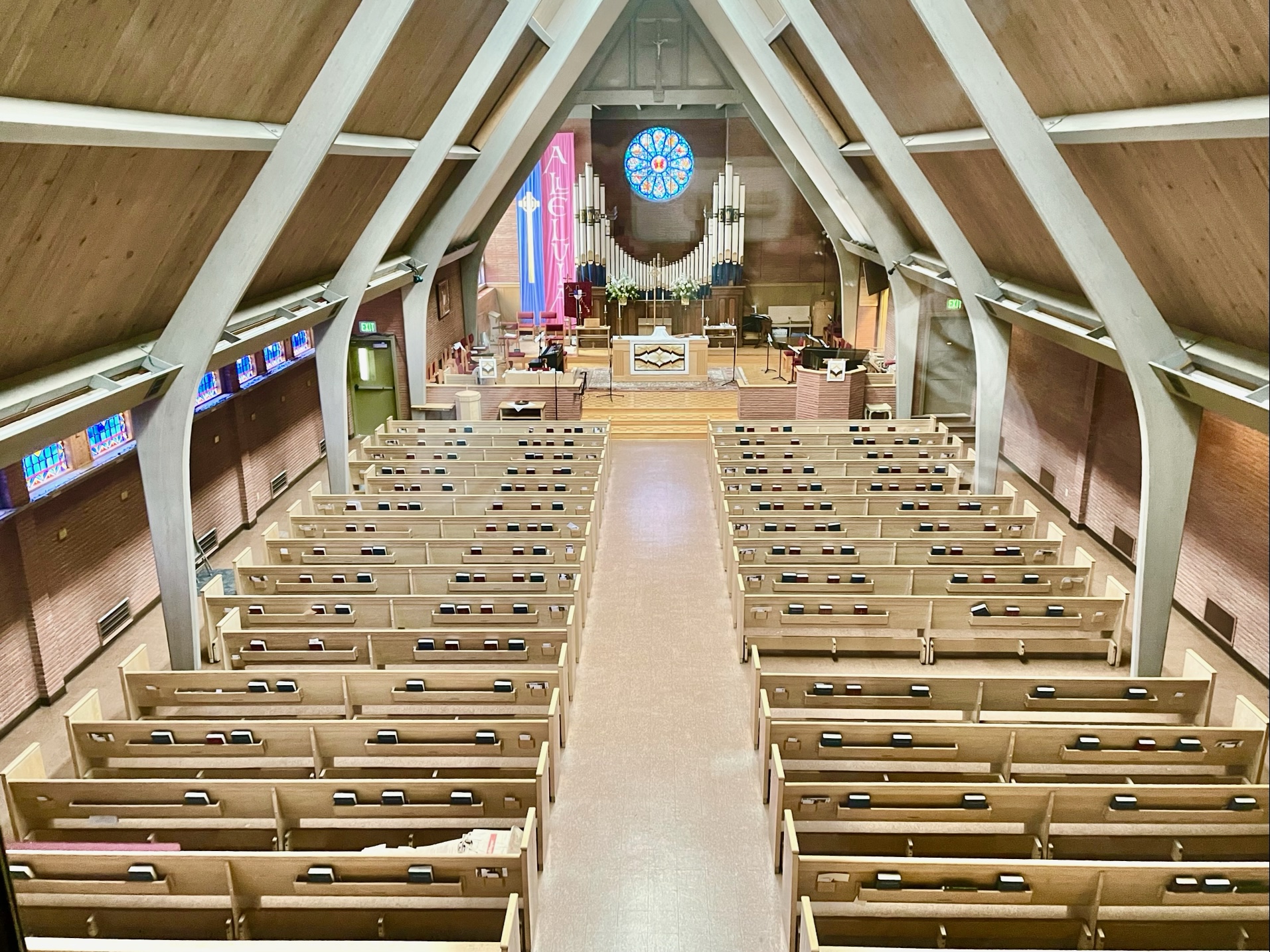
The sweep and grandeur of the passage of Christianity from the British Isles to us here at All Saints’ in Portland is beautifully portrayed by the finely crafted stained-glass windows featured in the main sanctuary. They are a vivid artistic vision of some of the historical steps along our journey as Anglican Christians.
The windows were Designed and executed by Jerry LaDuke. Design advisers to the artist were The Rev. Arlin J. Rothauge and The Rev. Arthur Latta.
They were dedicated on November 2, 1980 and Easter Sunday, 1982.
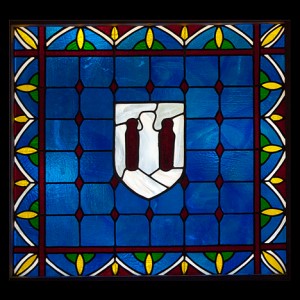
St. Joseph of Arimathea
Donors: Charles F. and Mary Bryant Hill
William Cullen Bryant, Jr.
Lloyd E. and Virginia E. Bryant
Memorial from friends
In Memory of Anna Isabella Bryant
William Cullen Bryant, Sr.
St. Joseph of Arimathea (1st Century) The legends of King Arthur and the search for the Grail and St. Joseph are intertwined. It was St. Joseph who allegedly brought the blood and sweat of Christ to England.
Symbols – The Two Cruets – are representative of the containers brought by St. Joseph containing the blood and sweat of Christ.
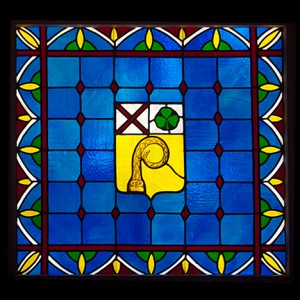
St. Patrick
Donors: Lloyd E. and Virginia E. Bryant
In Memory of Katherine J. Terry
Florence Terry Randall
St. Patrick (5th Century) was taken as a slave to Ireland when he was a child. Later, he escaped home to Britain. He returned to Ireland as a priest and was later consecrated Bishop of the Irish Church. The events of St. Patrick’s career are shrouded in legend. However, there is no question that he converted the people in an incredibly short time and when he died (461) Christianity and the Church were well established in Ireland and other parts of Britain.
Symbols – Cross – was used on the early Irish flag and was called Patrick’s Cross.
Shamrock – Is Patrick’s symbol for the Trinity. Crosier – tells that Patrick was a Bishop.
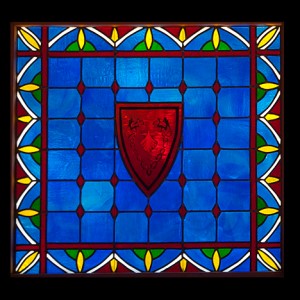
St. Columbanus
Donors: Dorothy Richardson
Mildred Enns
In Memory of: Glenn Jerry Richardson
Kitty Cameron
Alma Gregory
Henry Peter Enns
St. Columbanus (6th Century) was an Irish monk from the Isle of Iona. He was called “the Pilgrim” and it is written that he always “looked ahead and never back.” He was over 6 feet tall and possessed a fiery temper. As a missionary, he traveled through England and Europe, leaving a trail of monasteries all the way to northern Italy in a place called Bobbio. At the same time that Columbanus was converting and establishing monasteries, Pope Gregory the Great, was sending St. Augustine and a group of monks to Britain to re-establish Western Christianity.
Symbols – Shell – Symbol of the Pilgrim. Shield Color – red, because of his temper Interlacing with Zoomorphism – found in Celtic illumination and identifies his homeland.
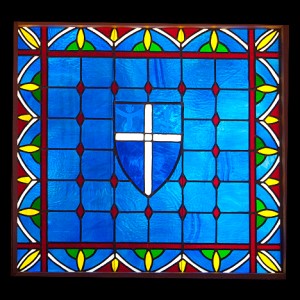
St. Augustine of Canterbury
Donors: Richard H. and Marjorie Lindquist
In Memory of: George E. and Ollie K. Lindquist Frank A. and Marie N. Erickson
St. Augustine of Canterbury (6th Century) was sent by Gregory the Great to re-find the Church in Britain. Upon his arrival, he discovered Celtic Christianity to be a vital and living presence there. The Established Church in Britain was attuned to an Eastern/Alexandrian calendar and polity. St. Augustine was responsible for bringing Western Christianity, with the Vulgate Bible and Roman calendar for Easter to the British Isles.
Symbols – Shield – is the official Coat of Arms of Canterbury Cathedral and is used here because St. Augustine was the first Archbishop of Canterbury.
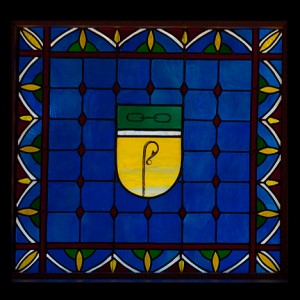
St. Hilda of Whitby
Donor: Grace Latham
In Memory of Josephine Webb Roberts George Lewis Robert
St. Hilda of Whitby (7th Century) was an abbess and an educator. She was responsible for calling the Synod of Whitby which settled the long-standing dispute between Celtic and Roman Christianity by adopting the Roman date for Easter. This decision brought the Church in England in touch with the flow of Western Catholic theology, practice, and influence.
Symbols – Linked Chain – symbolic of St. Hilda’s welding force at the Synod of Whitby.
Crosier – is one that an Abbess would carry.
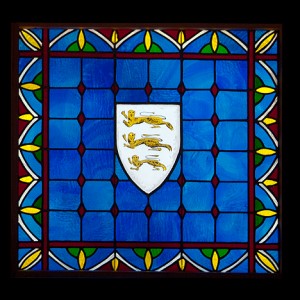
William the Conqueror (William I)
Donor: Grace Latham
In Memory of Lucy Lee Mays Latham
William the Conqueror (11th Century) was not a saint. He is remembered in our history because of his efforts to reform and strengthen the Church in England. William was always loyal to the Pope, but he was also determined to protect the rights of the English Church. When the Pope demanded that William do homage, thereby recognizing the Pope as his political superior, William refused. He established a balance of power between continental (Papal) influence in the Church in England and leadership exerted over the Church in England by the King.
Symbols – William had no coat of arms as this art had not been developed at the time. The Golden Lions of England are used here as they are found in the Royal Coat of Arms from a very early period.
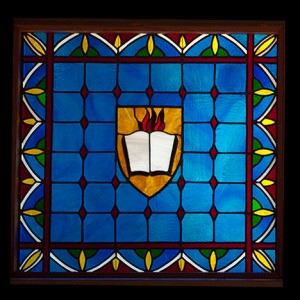
John Wycliffe
Donors: Marion Hunter Estate
Dorothy A. Pierce
Eleanor W. Leigh
Judith L. Slaalien
Memorial from friends
In Memory of: Marion Hunter
Albert J. Leigh
John Wycliffe (14th Century) was an Englishman who studied at Oxford, was ordained a priest and became a theologian of distinction. He is more familiarly known as a reformer and has been called the “Morning Star of the Reformation”. He attacked the Church’s wealth, its interference with the State, corruption of the clergy and abuses of their authority and privileges. He believed, as a means of overcoming ignorance and superstition, that the Bible should be in the hands of the people. He inspired the first translation of the Bible into English.
Symbols – Fire – stands for transformation and reformation.
Bible – symbolizes Wycliffe’s accomplishment: the Bible into English thus making it available to all literate persons.
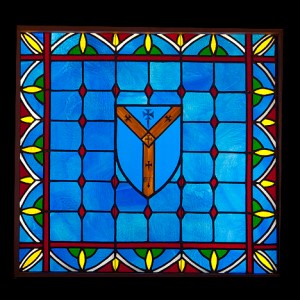
Thomas Cranmer
Donor: Mabel Pratt
Dedicated to: “The Glory of God”
Thomas Cranmer (15th-16th Century) was Archbishop of Canterbury under Henry VIII and so was instrumental in some of the formulations responsible for the Church in England becoming the Church of England. Much of the 1549 Prayer Book, the first English Prayer Book, was his work. This book has been influential in the liturgical reform of the Anglican Church in the present day.
Symbols – Because Cranmer was Archbishop of Canterbury, a portion of that Coat of Arms is used in the Shield.
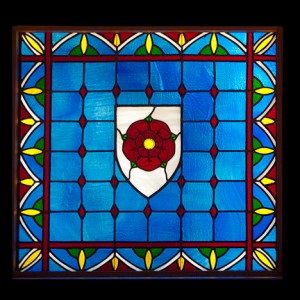
Queen Elizabeth I
Donors: Helen Bruun Anderson
In Memory of: Kay Bruun O’Neil
Elton and Ethel Kelly
Queen Elizabeth I (16th - 17th Century) was convinced that the British people wanted neither extreme Protestantism nor Roman Catholicism. She was responsible for the issuance of a Prayer Book (1559) which combined the strengths of Protestantism with the historical continuity of Catholicism in devotional literature and so in Church Practice. She also provided for the filling of many Sees.
Under Elizabeth, a new generation, nourished by the Prayer Book, grew up tolerating a view that was both reformed and Catholic – the “Elizabethan Settlement.” A school of theologians developed, expanding a theology commensurate with “via media.” Anglican principles began to emerge in Elizabeth’s reign, reaching the “Golden Age” in the 17th Century.
Symbols – Elizabeth is represented here with the Tudor Rose.
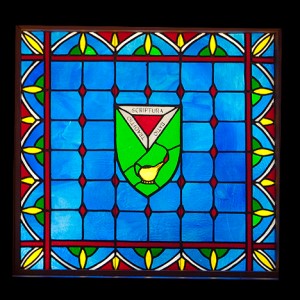
Richard Hooker
Donors: Thomas E. Petty
T. Michael and Sandra L. Petty
Kevin L. and Donna J. Petty
Michael D. and Heather (Petty) McNasser
In Memory of: Betty J. Petty
Richard Hooker (16th-17th Century) was born in 1553 or 1554 in Heavitree, Devonshire. He was educated at Oxford and became a Fellow at Corpus Christi College in 1577. Hooker was one of the celebrated Anglican Divines of the 17th Century. He presented a rationale for the “Elizabethan Settlement” which has stood the test of time. Scripture, Tradition, and Reason were three compatible sources of Christian revelation, teaching, and practice.
Symbols – Equilateral Triangle – symbolizes the balance of the three sources of revelation.
Lamp – symbolizes that true knowledge is inspired by the flame/fire of God.
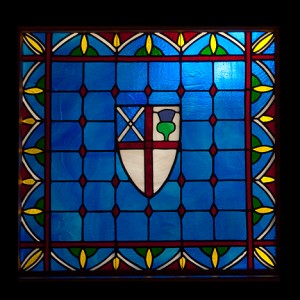
Samuel Seabury
Donors: David L. Shaw
Janet Marino Shaw
Edith A. Johnson
In Memory of Isabel Nairn Barbour Shaw
John Raymond Marino
Evan Ellsworth Johnson
Samuel Seabury (18th Century) After the Revolutionary War, the Anglican Church in America was in desperate straits. It had no bishops and because the ties with England had changed, it needed to be nationally independent and linked, ecclesiastically with the historic episcopate. The clergy in Connecticut elected Seabury as Bishop; he accepted and went to England to be consecrated. However, consecration in England was not possible because a loyalty oath to the King was required. He then traveled to Scotland where he was consecrated Bishop by Bishops Kilgour, Petrie, and Skinner of the Episcopal Church of Scotland. Thus, Samuel Seabury became the first Bishop of the Episcopal Church in America.
Symbols – St. Andrew’s Cross and Thistle – stand for Scotland.
Large Red Cross – is the Crusader Cross.
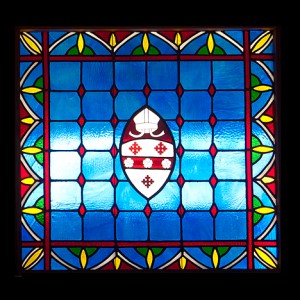
The Rt. Rev. Benjamin Wistar Morris
Donors: Memorial from family and friends
In Memory of Imogene Morrow
The Rt. Rev. Benjamin Wistar Morris (1819-1906) was the 2nd Missionary Bishop of the Washington and Oregon Territories, and the 1st Bishop of Oregon. At the age of 84, he established the mission of Our Savior, on the corner of SE 41st and Woodstock, Portland, Oregon, on property purchased from the Evangelic Church. The name was changed to All Saints in 1926 and it became a Parish in January 1945.
Symbols – Facsimile of the Seal of the Diocese of Oregon is used to symbolize Bishop Morris. Its description is as follows: Broad Red Fesse – situated horizontally across the shield, indicates the Oregon Trail and the heroism which carried the first Missionary Clergyman and many of the first American Episcopalians to Oregon by this means.
Crosses, Crosslets – at either side of the Trail, this peculiarly missionary form of the cross with its red color echoes the reference to the early missionaries, and the later Bishops, Clergy and Laity who continued the missionary efforts create the Diocese.
Roses – symbolize the See City of the Diocese, Portland, City of Roses. The rose is also the symbol of England and calls attention to the Anglican Communion of which the Episcopal Church is an autonomous member. The first members of this Communion in the Oregon Country were gentlemen of the Hudson’s Bay Company.
Vesica – (shape of the shield) body of a fish without tail or fins – symbol of Our Lord; first used by St. Clement of Alexandria in the 2nd Century.
(from The Shield of the Diocese of Oregon by Louise M. Clark)
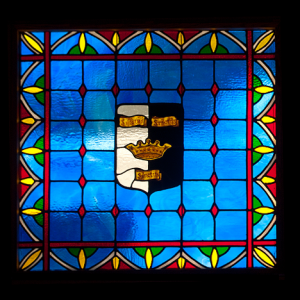
Shield of All Saints Episcopal Church
Donors: Members of All Saints’ Parish
Dedicated to: The Communion of Saints and The Glory of God
The All Saints’ Shield brings our journey from the 1st Century, represented by the 1st Window, to the 21st Century. It is a gift from the people of All Saints’.
Symbols – Sanctus, Sanctus, Sanctus – means Holy, Holy, Holy. Sanctus also means “Saint”.
Light and Dark Sides of Shield – our saints are on both sides of Death, together chanting the Great Holy, Holy, Holy.
Crown of Christ – whereby we can share in the family of God and whereby we cry “Abba, Father.”
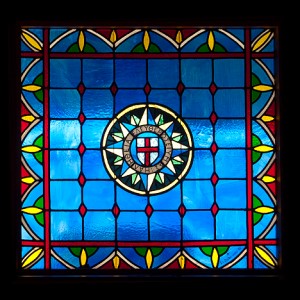
Shield of Anglican Communion
Donors: Members of All Saints’ Parish
Dedicated to: The Communion of Saints and The Glory of God
The Shield of the Anglican Communion. It is fitting that the final window represents the worldwide Anglican Communion. This window is also a gift from the people of All Saints’.
Symbols – Compass – worldwide.
Miter – Episcopate.
Cross in Shield – Crusader Cross.
Greek Letters – from the New Testament meaning: “The Truth Will Make You Free”. John 8:32
